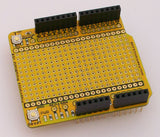New from Freetronics is our 170mm Electronics Ruler:
This is a great tool that will not only help you draw straight lines but us also covered with information that the electronics hobbyist or enthusiast will find of interest, such as:
- Ohm's Law reference
- Pinout of the AVR ICSP header commonly used on Arduino boards
- Common PCB track widths in both metric and imperial
- Electronics colour codes
- Formulae for calculating resistance and capacitance in parallel and series
- LED orientation guide
- Pinout and colour codes for the common FTDI-type serial cable
- Prefixes and multipliers for scale conversion
These great rulers are in stock now for only $4 including GST, so visit the product page for more information and to order! And for more - we're on facebook, Google+, and twitter - so follow us for news and product updates as well.
























